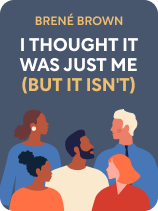

This article is an excerpt from the Shortform book guide to "I Thought It Was Just Me (but it isn't)" by Brené Brown. Shortform has the world's best summaries and analyses of books you should be reading.
Like this article? Sign up for a free trial here.
What is Brené Brown’s shame resilience theory? How can you combat shame with empathy?
Shame is a natural human emotion, but it doesn’t mean you should feel it all the time. In I Thought It Was Just Me (but it isn’t), Brené Brown explains her shame resilience theory that helps you develop three practices to break down shame.
Let’s explore the three main practices that Brown recommends you integrate into your daily life.
Practice #1: Acknowledge Your Shame and What Causes It
First, Brené Brown notes, to start building empathy and combating shame, you must recognize when you’re experiencing it and what’s causing it. Recognizing your shame and its causes will allow you to separate from your negative thoughts and emotions before they can cause you to experience fear, react with blame, and become disconnected from yourself and others. Acknowledging your shame will enable you to practice courage, compassion, and connection.
There are two parts to the first of Brené Brown’s shame resilience practices. The first is to identify how shame feels. The second is to identify the identities and situations that cause that shame.
Practice #2: Develop Critical Awareness of Shame
Brown explains that a second vital practice in developing empathy and combating shame is to understand shame with critical awareness. Brown defines critical awareness (as it relates to shame) as an understanding of why we deem certain identities as shameful, how shame around these identities impacts society, who’s most affected by the shame of identities, and who benefits the most from them. Try to understand each of the disdained identities you identified in Practice #1 with critical awareness.
To develop critical awareness about shame, think of an identity that makes you feel ashamed. Which components of this shameful identity contradict society’s or your inner circle’s expectations? Then, think of the ideal you feel like you’re supposed to be living up to instead, and consider its impact on society at large: Who suffers because of this ideal’s existence, and who profits from it?
For example, you may feel ashamed for looking “poor” rather than “upper-class.” Looking “poor” could mean wearing unfashionable clothes or owning outdated technology instead of always wearing new, fashionable clothes and having the newest technology—these being things that society expects “upper-class” people to do. On a societal level, the shame around this identity causes people to judge each other’s worth based on the materials they own. This materialism probably serves to benefit big businesses at the expense of average people who feel ashamed for looking poor.
Critical awareness makes you realize that most disdained identities are unfairly demonized and stem from unrealistic expectations that harm one group of people to benefit another. Brown explains that this realization helps you combat shame in a few ways.
First, it makes you understand that failing to meet unrealistic or unfair expectations doesn’t make you defective (boosting courage). Second, it makes you realize that you’re not the only person suffering from these expectations and pressures—others are dealing with similar pain (fostering compassion). Finally, sharing this realization with others can decrease the prevalence of shame and help de-stigmatize “shameful” identities (helping you connect with others).
Practice #3: Learn to Talk About Shame and Connect With Others
Brown’s final practice for developing empathy and combating shame is learning how to talk about shame and connect with others. We connect with others by sharing experiences and establishing mutual support. This is crucial to combating shame because it facilitates the empathy element of connection, which helps you put courage and compassion into action. Further, once you learn how to express your own shame and ask for support, you’ll be better equipped to listen to others and provide them with support.
(Shortform note: Research supports the idea that having social support systems is crucial to building resilience against negative experiences and emotions (like shame). Studies have even noted a link between social support and the neurocognitive systems and genetic mechanisms related to resilience. However, like Brown, Douglas Stone, Bruce Patton, and Sheila Heen explain that learning how to talk about our experiences and listen to others is crucial to ensuring that these connections have a positive effect. In Difficult Conversations, Stone, Patton, and Sheen explain that if we don’t share our feelings in a productive way and truly listen to others when they share theirs, we could end up misunderstanding each other, not getting what we need, and ultimately damaging our relationships).

———End of Preview———
Like what you just read? Read the rest of the world's best book summary and analysis of Brené Brown's "I Thought It Was Just Me (but it isn't)" at Shortform.
Here's what you'll find in our full I Thought It Was Just Me (but it isn't) summary:
- Brené Brown's guide on what shame is, why it happens, how it impacts our lives
- How to build empathy and combat shame
- Why it's important to talk about shame with others






